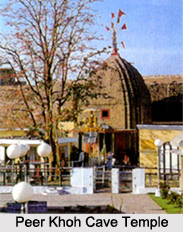 Peer Khoh Cave Temple is a famous temple in Jammu, which revolves around the epic of "Ramayana". The Peer Khoh Cave Temple is also known as "Jamwant Cave" and it is at a proximity to the Tawi River. The temple is dedicated to the Hindu God of destruction, Lord Shiva, while Swayambhu `Shiva Lingam` is the presiding deity. Considered to be one of the most ancient Shrines of the region, the Peer Khoh Cave Temple is situated in the midst of an acacia forest. Locals believe that the temple acts as a gateway to other pilgrimage shrines and caves located outside India. There are two natural caves inside this shrine, each having a depth of about 20 to 30 feet. To reach the Shiva Lingam, visitors have to go through a flight of several marble steps from the ground level. The "Panjbakhtar Temple", "Ranbireshwar Temple" and "Aap Shambu Temple" are other temples located in proximity to the Peer Khoh Cave Temple.
Peer Khoh Cave Temple is a famous temple in Jammu, which revolves around the epic of "Ramayana". The Peer Khoh Cave Temple is also known as "Jamwant Cave" and it is at a proximity to the Tawi River. The temple is dedicated to the Hindu God of destruction, Lord Shiva, while Swayambhu `Shiva Lingam` is the presiding deity. Considered to be one of the most ancient Shrines of the region, the Peer Khoh Cave Temple is situated in the midst of an acacia forest. Locals believe that the temple acts as a gateway to other pilgrimage shrines and caves located outside India. There are two natural caves inside this shrine, each having a depth of about 20 to 30 feet. To reach the Shiva Lingam, visitors have to go through a flight of several marble steps from the ground level. The "Panjbakhtar Temple", "Ranbireshwar Temple" and "Aap Shambu Temple" are other temples located in proximity to the Peer Khoh Cave Temple.
Legend of Peer Khoh Cave Temple
Peer Khoh Cave Temple is a highlight of Jammu city as history; myth and legend all combine at this place. Based on the epic Ramayana, it is believed that Jamvant (the bear god) adopted the cave as a place where he went into deep meditation. The temple is located on the banks of Tawi River and is now dedicated to Lord Shiva. The Shivling inside the temple is revered a lot by the locals and tourists alike. There is an ancient charm to the place that makes a visit here replete with devotional fervour. The Shivling is known as the Swayambhu Shivling and the cave as Jamvant cave. The forests around the temple comprise acacia trees and the geology is based on igneous rocks.
Festival at Peer Khoh Cave Temple
The temple is abuzz with activities during the Shivaratri festival and traditional gaiety is the well marked. Thousands of devotees visit this cave temple during the occasion of `Shivaratri`, a Hindu festival celebrated in honour of Shiva.
How to Reach Peer Khoh Cave Temple
Located near the Tawi river in Jammu one can reach the temple easily by any means of transport in the city. At a distance of 8 kms from the city is Jammu Airport, which is well-connected to other places across the country. The Jammu-Tawi railway station is linked to various cities of the country as far as Trivandrum in Kerala. A good network of roads connects Jammu to major north-Indian cities like Chandigarh, Ambala and New Delhi.





















